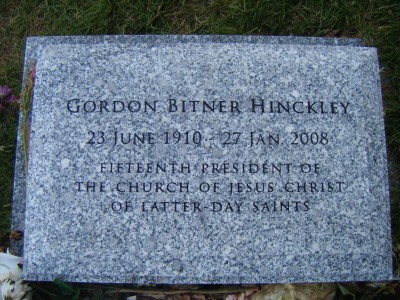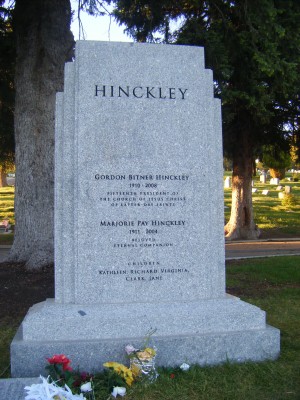Gordon Hinckley (Gordon Bitner Hinckley)

A muiti-generational Latter-day Saint, Hinckley was born in Salt Lake City, Utah, to prominent LDS writer and educator Bryant S. Hinckley and Ada Bitner Hinckley. He graduated from LDS High School in 1928. He grew up on a residential farm in East Millcreek. His home library contained approximately a thousand volumes of literary, philosophical and historical works. Hinckley was known for his optimism and plain-speaking. Hinckley attended the University of Utah, where he earned an undergraduate degree in English, and minored in ancient languages. He studied Latin and could read ancient Greek. Hinckley became a missionary for the LDS Church, an unusual occurrence for Depression-era Latter-day Saints. He served in the London-based British Mission from 1933 to 1935. He would later write the words for LDS hymn no. 135, “My Redeemer Lives”.
Hinckley returned to the United States in 1935 after completing a short tour of the European continent, including preaching in both Berlin and Paris. He was given an assignment by his mission president, Joseph F. Merrill, to meet with the church’s First Presidency and request that better materials be made available to missionaries for proselytizing. As a result of this meeting, Hinckley received employment as executive secretary of the church’s Radio, Publicity and Missionary Literature Committee (he had received schooling as a journalist in college). Hinckley’s responsibilities included developing the church’s fledgling radio broadcasts and making use of the era’s new communication technologies. Starting in 1937, he also served on the Sunday School General Board. After the Second World War, Hinckley served as executive secretary to the church’s Missionary Committee. He also served as the church’s liaison to Deseret Book, working with Deseret Book’s liaison to the church, Thomas S. Monson. At various times, especially in the late 1940s, Hinckley was also a reporter for the Church News, a publication of the Deseret News. In the early 1950s, Hinckley was part of a committee that considered how to present the temple ordinances at the Swiss Temple. The concern was how this could be done when a need existed to provide them in at least 10 languages; the concern was eventually solved through the use of a film version of the endowment. Hinckley’s background in journalism and public relations prepared him well to preside over the church during a time when it has received increasing media coverage.
On April 29, 1937, Hinckley married Marjorie Pay (November 23, 1911 – April 6, 2004) in the Salt Lake Temple. They had five children, including Richard G. Hinckley, a general authority of the LDS Church since 2005, and Virginia Hinckley Pearce, a former member of the general presidency of the church’s Young Women organization. Another of their daughters, Kathleen Hinckley Barnes Walker, co-authored several books with Virginia, and ran an events company. Her first husband, Alan Barnes, died in 2001 and in 2004 she married M. Richard Walker. The Walkers served for three years as president and matron of the Salt Lake Temple and in 2010 began presiding over the Missionary Training Center in Preston, England. Hinckley’s other son, Clark, has also served in several church leadership positions, including stake president and as president of the church’s Spain Barcelona Mission from 2009 to 2012. In 1958, Hinckley became a church general authority in the now-discontinued position of Assistant to the Quorum of the Twelve Apostles. In September 1961, he became an apostle in the Quorum of the Twelve Apostles. He filled a vacancy created by Hugh B. Brown being added to the First Presidency as the third counselor to David O. McKay.
On July 23, 1981, Hinckley became a counselor in the First Presidency. As the 1980s progressed, the health of church president Spencer W. Kimball and his aging counselors, N. Eldon Tanner and Marion G. Romney, led to Hinckley being the only healthy member of the First Presidency. When Tanner died in 1982, Romney succeeded him as first counselor and Hinckley succeeded Romney as second counselor. Because of the ill health of Kimball and Romney, Hinckley had increased responsibility for much of the day-to-day affairs of the First Presidency. The Mark Hofmann document forgeries, bombings, and investigation occurred during this time. Among the documents forged by Hofmann, the Stowell Forgery—which appeared to implicate Joseph Smith in gold digging—was purchased by the church under Hinckley’s direction.[citation needed] Two years later, after media inquiries initiated by Hofmann, the document was released to scholars for study and determined to be a forgery.
After Kimball’s death in November 1985, Ezra Taft Benson, who had been President of the Quorum of the Twelve Apostles, became President of the Church and named Hinckley as first counselor, with Thomas S. Monson of the Twelve as second counselor. For several years, all three members of the First Presidency were able to perform their duties. In the early 1990s, however, Benson developed serious health problems that removed him from public view, leaving Hinckley and Monson to carry out many of the duties of the First Presidency until Benson died in 1994. After Benson’s death, Howard W. Hunter became President and retained Hinckley and Monson as counselors in the First Presidency. At the same time, Hinckley became President of the Quorum of the Twelve Apostles by virtue of seniority.
When Hunter died after a presidency of nine months, Hinckley succeeded to the presidency of the church at the age of 84, on March 12, 1995. On November 2, 2006, Hinckley surpassed David O. McKay to become the oldest LDS Church president in history. Hinckley was known for accelerating the building of temples. When he became president, there were 47 operating temples in the church; at the time of his death, there were 124, over two-thirds of which had been dedicated or rededicated under Hinckley, with 14 others announced or under construction. Hinckley oversaw other significant building projects, including the construction of the Conference Center and extensive renovations of the Salt Lake Tabernacle.
On September 23, 1995, Hinckley released “The Family: A Proclamation to the World”, a statement of belief and counsel regarding the sanctity of the family and marriage prepared by the First Presidency and Quorum of the Twelve.[16] In February 1996, church membership in countries other than the United States surpassed that of the U.S. The year 1996 also saw the broadcast of a 60 Minutes interview of Hinckley by Mike Wallace during a segment on the LDS Church. In 1998, Hinckley was a guest on CNN’s Larry King Live. Hinckley maintained a friendship with both Wallace and King until his death. In November 2000, Hinckley spoke to the youth of the church and gave them six traits to work on, named the “Six Be’s” (Be Grateful, Be Smart, Be Clean, Be True, Be Humble, Be Prayerful), which were first introduced in his New York Times Bestseller Standing for Something and later expanded on in Way to Be. On March 31, 2001, Hinckley announced the creation of the Perpetual Education Fund, an endowment that provides loans to students in developing nations. On October 22, 2002, Hinckley participated in the dedication of the Gordon B. Hinckley Building at Brigham Young University–Idaho in Rexburg, Idaho. This was the first building at BYU–Idaho to be named for a then-living church president.
In April 2003, Hinckley gave a sermon that addressed the ongoing War in Afghanistan and the Iraq War, which had started just two weeks earlier. He said, “as citizens we are all under the direction of our respective national leaders. They have access to greater political and military intelligence than do the people generally,” adding, “[f]urthermore, we are a freedom-loving people, committed to the defense of liberty wherever it is in jeopardy.” He also noted that “[i]t may even be that [the Lord] will hold us responsible if we try to impede or hedge up the way of those who are involved in a contest with forces of evil and repression.” In March 2005, Hinckley, together with Thomas S. Monson and James E. Faust, celebrated their tenth anniversary as the First Presidency—the first time in the history of the church that a First Presidency had continued for such a period of time without personnel changes.
On January 24, 2006, Hinckley underwent surgery to remove cancerous growths from his large intestine. He was also diagnosed with diabetes at that time. In June 2006, Hinckley traveled to Iowa City, Iowa, to speak at a commemoration of the 150th anniversary of the start of the Mormon handcart companies. On June 23, 2006 (his 96th birthday), Hinckley participated in a groundbreaking ceremony at Brigham Young University in Provo, Utah, for a new building that was to be named in his honor. The building was named the Gordon B. Hinckley Alumni and Visitors Center and was completed and dedicated on Hinckley’s 97th birthday. On March 31, 2007, Hinckley rededicated the Salt Lake Tabernacle after extensive renovation. Hinckley’s last public appearance was on January 4, 2008, when he offered the prayer at the rededication of the Utah State Capitol. During his tenure as president, Hinckley gave over 2,000 speeches; he traveled nearly a million miles over a lifetime to more than 160 countries, as he met with church members and dedicated meetinghouses and temples.
On January 27, 2008, Hinckley died at the age of 97 while surrounded by family in his Salt Lake City apartment. According to a church spokesman, the death was due to “causes incident to age.” The Deseret Morning News reported that Hinckley had just gone through a treatment of chemotherapy a few days earlier, and had “worked until the very end.” The day following Hinckley’s death, thousands of LDS youth in 6 states organized a social network campaign to dress in “Sunday Best” to honor Hinckley. Thomas S. Monson became the presidential successor on February 3, 2008. Funeral services were held on February 2, 2008, at the Conference Center in Salt Lake City, to which tens of thousands attended. Hinckley was buried at the Salt Lake City Cemetery next to his wife, who had died almost four years earlier. Some of the soil that was used to bury him was imported from the grounds of the Preston England Temple in Lancashire; this was done because Hinckley had been a missionary in this region of England.
Born
- June, 23, 1910
- USA
- Salt Lake City, Utah
Died
- January, 27, 2008
- USA
- Salt Lake City, Utah
Cause of Death
- causes incident to age
Cemetery
- Salt Lake City Cemetery
- Salt Lake City, Utah
- USA



